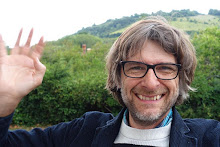
In a posting a few days ago I mentioned the ambiguity of standing with thousands of other people on the outside of a thin police cordon all looking in on the events unfolding in the square. Many people were filming what was happening, but in that moment of suspended animation, the roles and motivations of the onlookers were no longer self evident. Activists film to remind the police that they too are under scrutiny. Tourists film so that they can later demonstrate that they were indeed where they claim to have been. Protesters film to project the events in the square to the wider on-line audience, and thereby prove to the world that what they subjectively experienced in some transient moments really did form part of an objectively verifiable reality. I think there is a difference between these categories. However, the line dividing them occasionally blurs.
That morning, as I mentioned in the posting, I had been at a conference at the CCCB. The first speaker, Daniel Innerarity, delivered a paper entitled "The Observing Society". He was equating the proliferation of observation with a new form of democratic accountability. The subjugating gaze of Foucault's Panopticon is no longer uni-directional. It is not just the state that keeps citizens in check through its elaborate system of surveillance. Citizens have learned to turn the camera (or other apparatus of surveillance) around and subject the state to an interrogatory gaze. His thesis, as far as it goes, was born out by the events of Friday the 27th. Every move that the police made was being filmed by protesters and this was up on the blogs and websites in some cases within minutes of it having been taken. The evidence that it provided of the use of excess force contributed to the revitalization of the protest and since last Friday many more people have got involved. In other words, there's whatever happened in the square, in all it's fractured, contingent messiness and there is the mediated construction of that reality after the event across the various media platforms.
Which is fine, except there seemed to something that Innerarity was missing out, something about the inherent danger or uncaaniness, or something about the way immediate reality is so subjugated to the demands of mediation. A friend, "The Amazing Beryl" told me that she had seen a group of protesters filming a bunch of police who were filming them. No need to come to blows, reality is elsewhere, all that was happening there was "content" creation. I had a camera in my pocket and it occurred to me to start filming as I, along with thousands of others, re-entered the square and watched as the Mosos retreated. It would have been a great film- especially the last five Mosos to leave who put on a show of bravado, firing their rubber bullets in the air, before withdrawing. But I felt, as I often do in these situations, that I didn't want to experience what was happening through the prism of what would make a good film and what would tell the story that I would like to be told when the video is played back later. I kind of kick myself now. Sod what was happening, that was essentially transient and meaningless. Far more important was that great vid that would have really "captured" the situation. After all, and to paraphrase Baudrillard, it's not that mediation distorts, undermines or covers up reality. This would in fact leave reality unscathed in the sense that it is presupposed, as if we know what we are talking about. Instead, mediation has supplanted reality, it has become reality. What we care about isn't what happens in the square, but rather the narratives which are constructed out of the "content" which the square provides. And that feeds back into the supposed immediacy of what is going on in the square, such that peoples actions are determined by the knowledge that they are involved in a fight to control the narrative, which largely takes place elsewhere across the various media platforms. So it's not enough to be peaceful, they have to put on a performance of 'being peaceful'. Hence the flowers and free hugs.
Returning to Innerarity's confidence that the prolferation of observation can be seen in terms of an inversion, or leveling out of Foucault's notion of a surveillance society, I wonder whether the significance of this lies not in questions of democracy and accountability, but rather in this question of the totalizing effect of mediation.




